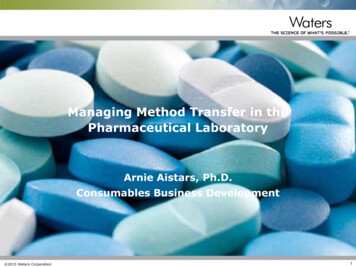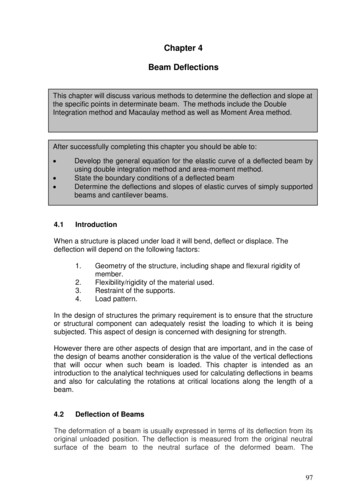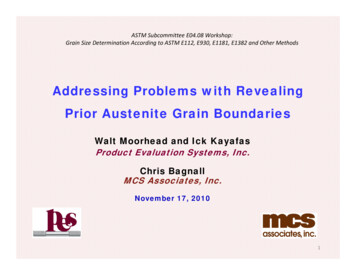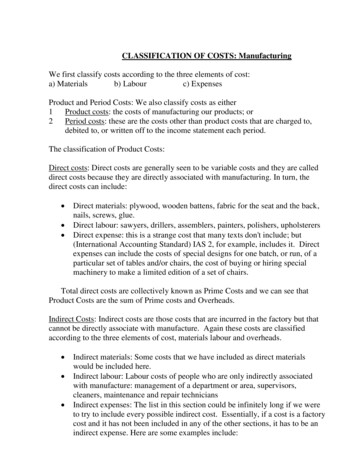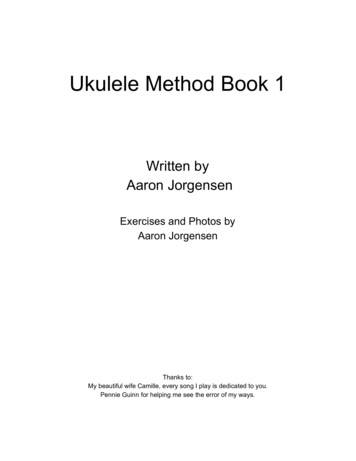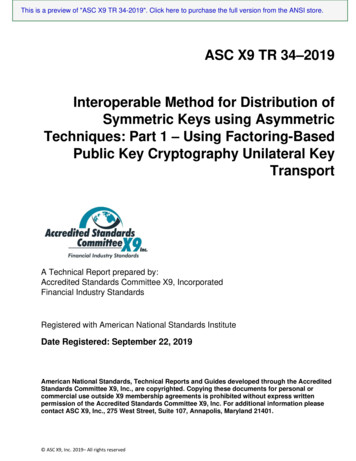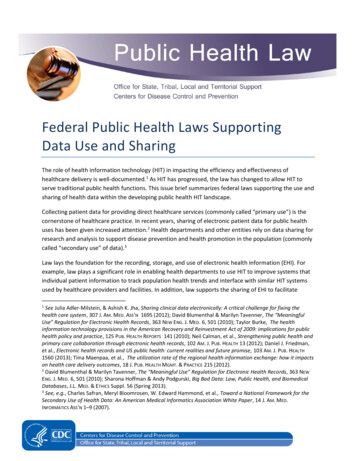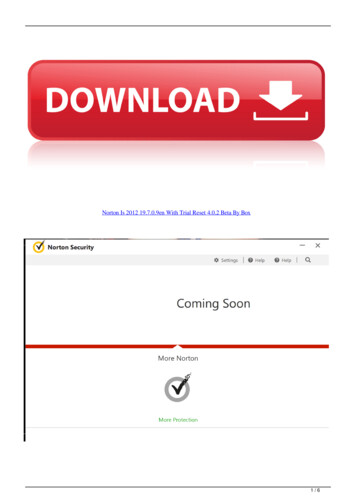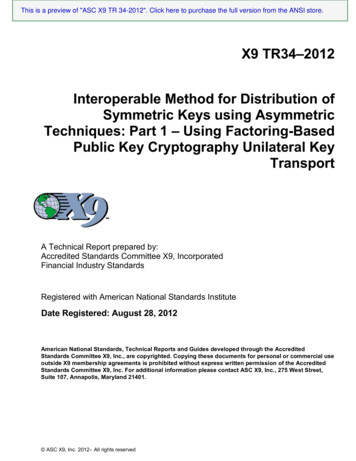
Transcription
This is a preview of "ASC X9 TR 34-2012". Click here to purchase the full version from the ANSI store.X9 TR34–2012Interoperable Method for Distribution ofSymmetric Keys using AsymmetricTechniques: Part 1 – Using Factoring-BasedPublic Key Cryptography Unilateral KeyTransportA Technical Report prepared by:Accredited Standards Committee X9, IncorporatedFinancial Industry StandardsRegistered with American National Standards InstituteDate Registered: August 28, 2012American National Standards, Technical Reports and Guides developed through the AccreditedStandards Committee X9, Inc., are copyrighted. Copying these documents for personal or commercial useoutside X9 membership agreements is prohibited without express written permission of the AccreditedStandards Committee X9, Inc. For additional information please contact ASC X9, Inc., 275 West Street,Suite 107, Annapolis, Maryland 21401. ASC X9, Inc. 2012– All rights reserved
This is a preview of "ASC X9 TR 34-2012". Click here to purchase the full version from the ANSI store.X9 TR34–2012ContentsPage1Scope .172References.183Terms and definitions .184Symbols and abbreviated terms .1855.15.25.2.15.2.25.3Key Block Properties and Characteristics .23Key Block Elements .23Key Block Binding Method .23Secrecy .25Integrity and Authenticity .25Key Block Header 06.86.8.16.8.2Key Establishment Protocol – Unilateral Key Transport Method .26Introduction .26Bind / Unbind / Rebind States .26Unbind / Rebind Scenarios .27Parameters for Digital Signatures .28Digital Signatures .28KDH Bind Phase .28Summary.28Prepare KRD Credential Token (A1) .28Validate KRD Credential Token (B1) .28Prepare KDH Credential Token (B2) .28Validate KDH Credential (A2) .28TDEA Symmetric Key Transport Phase .30Summary.30Generate Random Number Token (A1) .30Receive Random Number Token (B1) .30Generate transported TDEA Symmetric Key (B2) .30Generate Ephemeral TDEA Symmetric Key (B3) .30Encipher Key Block (B4) .30Encipher Ephemeral Key (B5) .31Construct Key Token (B6) .31Verify Key Token (A2) .31TDEA Symmetric Key Transport Phase - One-Pass Protocol Support .32Summary.32One-Pass Environment .32Ensuring Message Freshness with TimeStamps .32Implementing TimeStamps .33Generate Transported TDEA Symmetric Key (B1) .33Generate Ephemeral TDEA Symmetric Key (B2) .33Encipher Key Block (B3) .33Encipher Ephemeral Key (B4) .33Construct Key Token (B5) .33Verify Key Token (A1) .34TDEA Symmetric Key Verification Phase .35Summary.35Generate Key Check Value (A1) .35ii ASC X9, Inc. 2012– All rights reserved
This is a preview of "ASC X9 TR 34-2012". Click here to purchase the full version from the ANSI store.X9 fy Key Check Value (B1) . 35KDH Unbind Phase . 36Summary . 36Generate Random Number Token (A1) . 36Receive Random Number Token (B1) . 36Generate Unbind Token (B2) . 36Verify Unbind Token (A2) . 37KDH Rebind Phase . 38Summary . 38Generate Random Number Token (A1) . 38Receive Random Number Token (B1) . 38Generate Rebind Token (B2) . 38Verify Rebind Token (A2) . 39Higher Level Authority Unbind Phase . 40Summary . 40Generate Random Number Token (A1) . 40Receive Random Number Token (B1) . 40Generate Unbind Token (B2) . 40Verify Unbind Token (A2) . 41Higher Level Authority Rebind Phase . 42Summary . 42Generate Random Number Token (A1) . 42Receive Random Number Token (B1) . 42Generate Rebind Token (B2) . 42Verify Rebind Token (A2) . 2.6A (Informative) Design Considerations . 44Assumptions and Constraints . 44Assumptions . 44Constraints . 44Recommended Algorithms . 45General . 45Signature Algorithms . 45Encryption Algorithms . 45OAEP Parameters . 45Message Digest Functions . 46Key Sizes and Characteristics . 47Annex B (Informative) Cryptographic Message Encodings . 49B.1Overview . 49B.2Test Vectors . 49B.2.1 Sample Keys . 49B.2.2 Sample Data . 57B.3Root Certificate Authority Public Key Certificate . 72B.4CAKDH – Certificate Authority – KDH Certificate . 76B.5CAKRD – Certificate Authority – KRD Certificate . 80B.6CTKDH – The KDH Credential Token . 84B.7CTKRD - The KRD Credential Token . 90B.8KTKDH – The KDH Key Token – 1 Pass . 94B.8.1 1 Pass Key Token . 96B.9KTKDH – The KDH Key Token – 2 Pass . 101B.9.1 2 Pass Key Token . 103B.10RBTCA UNBIND – Higher Level Authority Rebind Token . 108B.11RBTKDH – KDH Rebind Token. 115B.12RTKRD – KRD Random Number Token . 124B.13UBTCA UNBIND – Higher Level Authority Unbind Token. 125B.14UBTKDH – KDH Unbind Token . 129 ASC X9, Inc. 2012– All rights reservediii
This is a preview of "ASC X9 TR 34-2012". Click here to purchase the full version from the ANSI store.X9 TR34–2012Annex C (Normative) ASN.1 Module for Object Identifiers .134Annex D (Normative) ASN.1 Module for TR34 CMS .136iv ASC X9, Inc. 2012– All rights reserved
This is a preview of "ASC X9 TR 34-2012". Click here to purchase the full version from the ANSI store.X9 TR34–2012FiguresFigure 1 — Comparison of TR-31 and TR-34 Key Binding Methods . 23Figure 2 — Key Block Binding Method using CMS types . 23Figure 3 — Binding States . 27TablesTable 1 — KDH Response and Phase . 26Table 2 — Unbind / Rebind Scenarios . 27Table 3— KDH Bind Phase . 28Table 4 — TDEA Symmetric Key Transport Phase . 30Table 5 - TDEA Symmetric Key Transport Phase - One-Pass Protocol . 32Table 6 — TDEA Symmetric Key Verification Phase . 35Table 7 — KDH Unbind Phase . 36Table 8 — KDH Rebind Phase . 38Table 9 — Higher Level Authority Unbind Phase . 40Table 10 — Higher Level Authority Rebind Phase . 42Table 11 - Supported Signature Algorithms . 45Table 12 - Supported Asymmetric Encryption Algorithms . 45Table 13 - Supported Message Digest Functions . 46Table 14 - Supported Key Sizes and Characteristics . 47Table 15 - Ephemeral Key types and Strengths . 47Table 16 - Transported Key Types and Strengths . 48 ASC X9, Inc. 2012– All rights reservedv
This is a preview of "ASC X9 TR 34-2012". Click here to purchase the full version from the ANSI store.X9 TR34–2012ForewordPublication of this Technical Report that has been registered with ANSI has been approved by the AccreditedStandards Committee X9, Incorporated, 275 West Street, Suite 107, Annapolis, MD 21401. This document isregistered as a Technical Report according to the “Procedures for the Registration of Technical Reports withANSI.” This document is not an American National Standard and the material contained herein is not normative innature. Comments on the content of this document should be sent to: Attn: Executive Director, AccreditedStandards Committee X9, Inc., 275 West Street, Suite 107, Annapolis, MD 21401,Published byAccredited Sta
Standards Committee X9, Inc., are copyrighted. Copying these documents for personal or commercial use outside X9 membership agreements is prohibited without express written permission of the Accredited Standards Committee X9, Inc. For additional information please contact ASC X9, Inc
